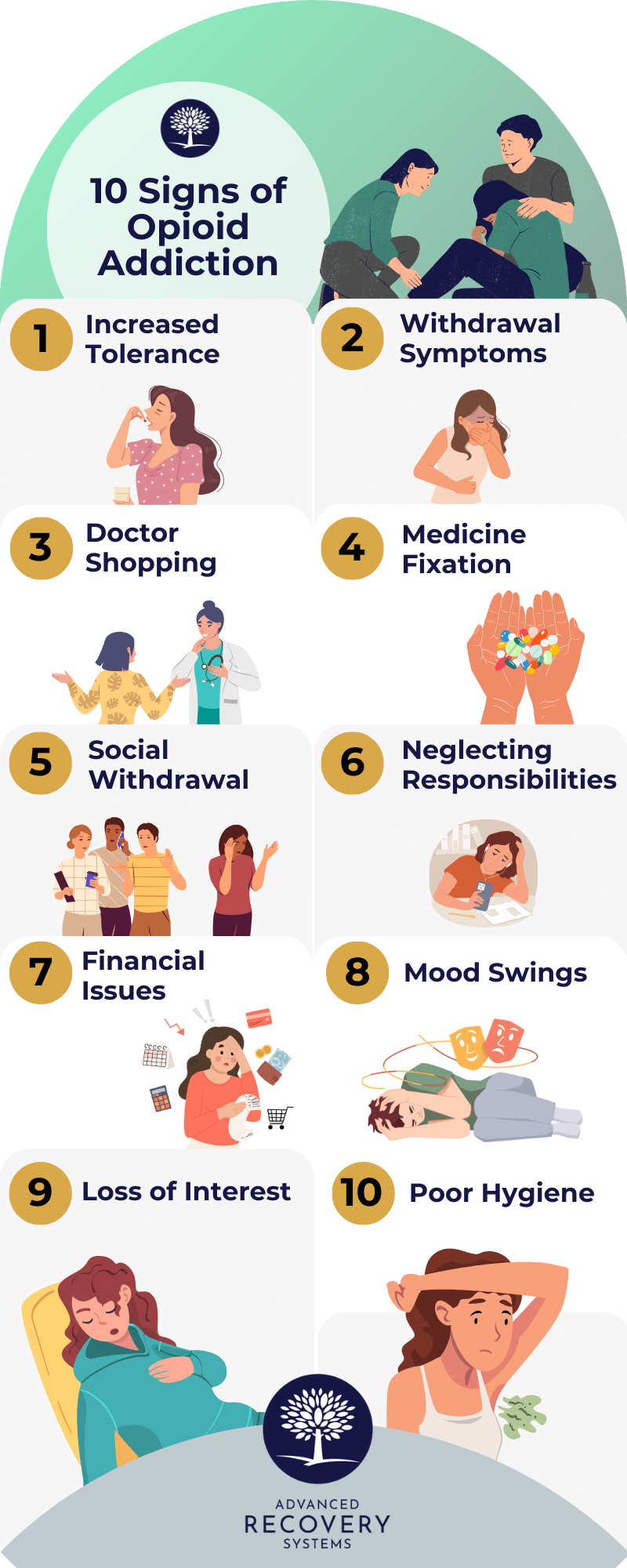Warning signs and symptoms that indicate the use and abuse of Opiates including observable behavioral and physical symptoms.
Opiates, which are alsocommonly called opioids, are a group of drugs that are primarily used to treat pain. They get their name from the opium poppy, from which they are derived. The terms opiates and opioids are used to describe both natural (opiate) and synthetic (opioid) medications.
What Are Opioids?
Opioids are a group of drugs used to treat pain. They are often prescribed by doctors for people who have chronic pain or had surgery. Unfortunately, these drugs are highly addictive and can lead toopioid addictioneven when taken as prescribed. Opioids reduce pain by binding to receptors in the central nervous system andinterrupt pain signals transmitted to the brainfrom other body systems. This effect can lead to pain reduction and a feeling of euphoria.
When considering the signs of opiate abuse, it’s important to realize that while some people start out using these drugs recreationally, many do not. They begin using them as prescribed by their care provider, but as they quickly develop a tolerance, they may start abusing the drugs and that’s how addiction develops.
Which Opioids Are the Most Commonly Abused?
Common types of prescription opioids include:
New Year, New Beginnings.
Whether you are struggling with addiction, mental health or both, our expert team is here to guide you every step of the way. Don’t wait— reach out today to take the first step toward taking control of your life.
- Heroin, which is made from morphine, is classified as an opiate. Heroin is aSchedule I controlled substancewith no accepted medical use and a high potential for abuse.
- Codeineis prescribed to help manage pain and suppress coughing. When codeine contains more than 90 mg per dosage unit, it’s considered to be aSchedule II controlled substance.
- Fentanylis a prescription opioid painkiller that is used to rapidly treat severe pain when other alternatives aren’t successful. It, too, is classified as aSchedule II controlled substance.
- Hydrocodoneis a prescription opioid that is used for managing pain and suppressing coughs. Hydrocodone is classified as aSchedule II controlled substance.
- Meperidineis often prescribed for moderate-to-severe pain, such as after childbirth, and it’s sometimes used to put people to sleep before a procedure.It is classified as aSchedule II controlled substance.
- Methadonehelps people addicted to other drugs experience a reduction inopioid withdrawal symptoms. Despite this, methadone has the potential to become highly addictive. It is classified as aSchedule II controlled substance.
- Morphineis aschedule II drugthat is prescribed for pain, which requires around-the-clock treatment, such as cancer-related pain and post-surgery pain.
- Oxycodone, the synthetic product of the opium poppy, is used to treat pain. It is classified as aSchedule II controlled substance.
Physical Signs of Opiate Addiction & Abuse
When people first start using opioids, they may feel itchy when they take them. They may alsofeel nauseatedand may even vomit. Some other signs of opiate use may include constipation and slower reaction times or movements. Because constipation is a symptom of use, it could lead the person to start using laxatives.

With heroin, some of the short-term symptoms of use can include nausea, vomiting, slowed breathing, itching and drowsiness. After someone takes heroin, they will usually get flushed skin, constricted pupils and dry mouth. Skin infections can occur if someone is regularly using heroin by injecting it into his or her veins. Suppression of the immune system can cause an opiate user to become sick more frequently.
Behavioral & Lifestyle Signs of Opioid Abuse
It can be difficult to determine if someone is abusing opiates because it may be easy for the person to hide some of the physical symptoms. However, there aregeneral behaviors and lifestyle patternsthat may be easier to recognize.
Some behavioral signs may include:
- Withdrawal from activities and commitments
- Loss of interest in hobbies
- Hanging out with new people
- Irritability
- Nervousness
- Secrecy
- Lying
When someone is addicted to opioids, they tend to withdraw from activities and commitments, such as school or work. They tend to lose interest in things they were previously interested in, and they may also start following different habits or routines, and hanging out with different people.
There can be attitude changes such as irritability and angry outbursts. Other behavioral signs include a sense of anxiety or nervousness, secrecy or dishonesty.
Families and loved ones of people who are abusing opioidswill tend to see that their loved ones start to focus elsewhere — often on figuring out ways to obtain more of the drug they’re abusing. This process tends to lead the individual to become even more disconnected from their previous life. Besides neglecting school, work, and family commitments, people may start to neglect their physical appearance as well.
As drug addiction progresses, many people start taking extreme measures to obtain drugs. With opioids, the body is usually quick to develop tolerance, meaning that the person abusing opioids will need continuously higher doses to get high. This necessity often leads them to steal pills from relatives or to take money to support their addiction.
“Doctor shopping” may occur, which means the person abusing drugs will start visiting many different physicians and creating fake symptoms in the hope of obtaining opioid prescriptions.
Finally, when someone is on opiates, they may resort to extreme behavior, either because of how the drugs have altered their thinking or to support their addiction. This behavior can lead to arrests or other problems with the law.
Withdrawal Symptoms of Opioids
People who are on drugs, including opioids, can learn ways to hide their use, and it can be difficult for family members to know for sure whether or not they are abusing substances. While you may not notice physical symptoms of the actual use of the drug, another way to know if someone is on drugs is to look out for withdrawal symptoms. When someone is a prolonged opioid user, they will experience withdrawal symptoms if they don’t take the drug — even for a short period.
Opioid withdrawal symptoms may include:
- Headache
- Nausea
- Vomiting
- Sweating
- Fatigue
- Extreme anxiety
Withdrawal from opioids can seem similar to the flu and can include physical symptoms such as a headache, nausea, vomiting, sweating, fatigue and extreme anxiety.
If you’re worried a loved one could be abusing opioids, it’s important to recognize both the physical and behavioral symptoms. These signs of opioid abuse can often be present very early on, and then they tend to worsen over time.



